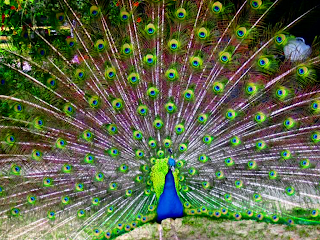Located on the Southern bank of the Ashley River just outside the city limits to the West of Charleston, SC, Magnolia Plantation
The land where Thomas and Ann Drayton built their home and a formal garden in the late 1670s was originally a rice plantation.
The core of the current house was built near Summerville, SC before the Revolutionary war, and floated down the Ashley River after the War between the States.
The plantation was owned by another Thomas Drayton (the great-grandson of the Thomas Drayton who bought the land) until his death in 1825 when, having no sons of his own list as heirs in his will, he bequeathed the land to the sons of his daughter Sarah.
Magnolia Plantation
Link goes to the official website for Magnolia Plantation & Garden " (page will open in new tab/window)
is one of the oldest plantations in the South, and has been owned by the same family for over 350 years and 15 generations.  |
| The plantation home |
The core of the current house was built near Summerville, SC before the Revolutionary war, and floated down the Ashley River after the War between the States.
The plantation was owned by another Thomas Drayton (the great-grandson of the Thomas Drayton who bought the land) until his death in 1825 when, having no sons of his own list as heirs in his will, he bequeathed the land to the sons of his daughter Sarah.
 |
| A beautiful day to relax in the grass |
John Grimké-Drayton later became the sole owner while studying for the ministry in England, after learning that his brother Thomas had died of a gunshot wound on the steps of the plantation home.
In 1838 Grimké-Drayton attended Episcopal seminary in Philadelphia, where he met and married Julia Ewing.
 |
| Showing off his plumage |
Believing the outside air would do him some good, he spent much of his time outdoors extensively reworking the gardens in an English style.
He intended to create a series of romantic gardens to make his bride Julia feel more at home in the lowcountry, and reportedly confided to a fellow minister in Philadelphia of his desire "...to create an earthly paradise in which my dear Julia may forever forget Philadelphia and her desire to return there."
 |
| What's this guy doing here? |
After Union troops burned the house in the War between the States, Grimké-Drayton opened the gardens to the public in 1870 as a tourist attraction to make money. The gardens at "Magnolia-on-the-Ashley" (as it came to be known) were the first privately owned gardens to be opened to the public.
The house and the slave cabins have been restored, and the plantation/home now serve as a museum and tourist attraction.
Magnolia Plantation is listed in the National Register
Magnolia Plantation is listed in the National Register
Magnolia Plantation
Link goes to the Historical Marker Database website (hmdb.org) (page will open in new tab/window)
of Historic Places. 
No comments:
Post a Comment